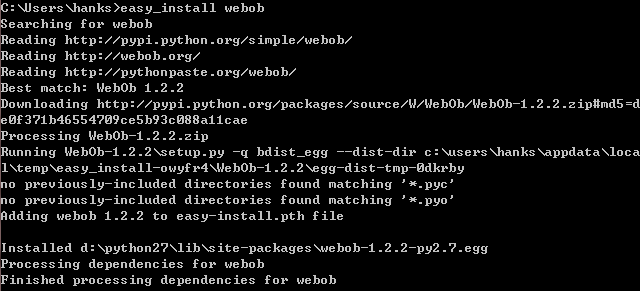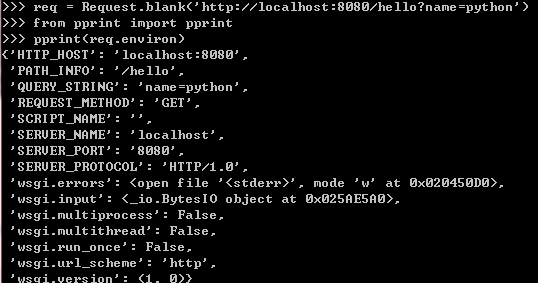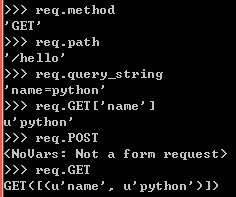python模拟Django框架实例
一、python实现web服务器
web开发首先要有web服务器才行。比如apache,但是在开发阶段最好有一个简单方便的开发服务器,
容易重启进行调试,等开发调试完毕后,再将代码部署到成熟稳定高效的web服务器。
# -*- coding: utf-8 -*-
from wsgiref import simple_server
# 定义一个输出 hello world 和环境变量的简单web应用程序
def hello_app(environ, start_response):
# 输出 http 头,text/plain 表示是纯文本
start_response('200 OK', [('Content-type','text/plain')])
# 准备输出的内容
content = []
content.append('Hello world')
for key, value in environ.items():
content.append('%s : %s' % (key, value))
# 输出,根据 wsgi 协议,返回的需要是一个迭代器,返回一个 list 就可以
return ['\n'.join(content)]
# 构造开发服务器对象,设置绑定的地址和端口,并把 hello world 应用程序传给他
server = simple_server.make_server('localhost', 8080, hello_app)
# 启动开发服务器
server.serve_forever()
执行上面这个程序后,打开浏览器,访问一个以 http://localhost:8080 开头的网址即可看到 environ 所包含的内容。

(截取一小部分)
二、基础知识
浏览器和web应用之间使用的是http协议,它规定了请求和响应的格式。
1、请求包(Http Request)
请求主要包括请求的方法,请求的URL,请求头,请求体。
请求的方法http规定有GET, POST, PUT, DELETE,只不过通过浏览器发起的web请求一般只涉及GET和POST请求。
GET一般用来获取服务器内容,POST类似修改内容,PUT添加,DELETE删除。
一般通过提交html的form表单发起POST请求。成功后需要进行重定向。
从协议上看GET,HTTP请求最大的区别就是GET请求没有请求体,而POST请求有。这就意味着可以通过POST请求
向服务器发送大量数据,如上传文件等,当然GET请求也可以通过URL本身以及其参数向服务器传递参数,比如
url?arg1=value&arg2=value
请求头就是包含了请求包的描述信息。 比如编码,包长度等。
2、响应包(Http Response)
http的响应包的格式更简单一些,包括状态码,响应头和响应体,状态码表示该请求的结果,比如
200表示成功
404表示资源没有找到
500表示服务器错误
301表示资源已经换了地址,客户端需要跳转。
响应头和请求头类似,包括一些描述信息,响应体一般就是输出内容了,大部分是页面html代码。
3、请求的生命周期
1. web服务器接收到原始的http请求后进行一定程度的包装再交给web应用程序
2. web应用程序处理后,再以一定的格式返回数据给web服务器
3. web服务器再将数据包装成http响应包返回给浏览器。
4、关于cgi
cgi(common gateway interface)就是web服务器与web应用程序之间的一个古老的协议,在cgi协议中,
web服务器将http请求的各种信息放到cgi应用程序的环境变量中,cgi应用程序再通过标准输出,输出它的响应头
和相应内容给web服务器。
上面用到的开发服务器与应用程序之间所使用的协议叫做wsgi,它和cgi类似,同样将请求包装成一种key-value对,
只不过cgi通过环境变量传给cgi应用程序,而wsgi直接使用python的字典对象来传递。
hello_app的第一个参数environ就是包含请求信息的字典对象,第二个参数是个函数,web应用程序在输出响应内容
前需要先调用它来输出状态码和响应头。
处理web请求和响应这里使用webob模块来处理请求和响应,需要安装,这里首先要安装setuptools模块,一个包管理的工具,可以通过这个工具自动下载需要的软件包,类似ubuntu的app-get。下面是地址:http://pypi.python.org/pypi/setuptools安装结束,可以直接在命令行中输入:easy_install webob这样就会自动下载安装。

简单使用:
>>> # 导入 Request 对象
>>> from webob import Request
>>> environ = {}
>>> # 使用 Request 来包装 environ 字典
>>> req = Request(environ)
使用一个Request类来包装environ,然后通过Request对象的属性和方法对environ进行访问。由于只有在一个web环境才能得到一个真实的environ字典,为了方便大家在shell中进行测试,webob提供了一个模拟简单web请求的方法:

也可以通过req查找其它有用的信息

同时也可以通过webob模块中的Response对象来包装响应信息。

下面使用webob模块重写之前的hello_app
# -*- coding: utf-8 -*-
from wsgiref import simple_server
from webob import Request, Response
# 我们顺便增加了一个功能,就是根据用户在 URL 后面传递的参数
# 显示相应的内容
def hello_app(request):
content = []
# 获取 get 请求的参数
content.append('Hello %s'%request.GET['name'])
# 输出所有 environ 变量
for key, value in request.environ.items():
content.append('%s : %s' % (key, value))
response = Response(body='\n'.join(content))
response.headers['content-type'] = 'text/plain'
return response
# 对请求和响应进行包装
def wsgi_wrapper(environ, start_response):
request = Request(environ)
response = hello_app(request)
# response 对象本身也实现了与 wsgi 服务器之间通讯的协议,
# 所以可以帮我们处理与web服务器之间的交互。
# 这一句比较奇怪,对象使用括号是什么意思。。。。
return response(environ, start_response)
server = simple_server.make_server('localhost', 8080, wsgi_wrapper)
server.serve_forever()
为了让 wsgi_wrapper 更加通用一点,可以把它设计成装饰器的形式:
# -*- coding: utf-8 -*-
from wsgiref import simple_server
from webob import Request, Response
# 写成装饰器的 wsgi_wrapper
def wsgi_wrapper(func):
def new_func(environ, start_response):
request = Request(environ)
response = func(request)
return response(environ, start_response)
new_func.__name__ = func.__name__
new_func.__doc__ = func.__doc__
return new_func
# 应用程序
@wsgi_wrapper
def hello_app(request):
content = []
content.append('Hello %s'%request.GET['name'])
for key, value in request.environ.items():
content.append('%s : %s' % (key, value))
response = Response(body='\n'.join(content))
response.headers['content-type'] = 'text/plain'
return response
server = simple_server.make_server('localhost', 8080, hello_app)
server.serve_forever()
三、模板
果然,还是需要用到模板,不能总是直接在Response中写上长串的html代码。
python中的模板引擎主要有mako, genshi, jinjia等。
mako 主要特点在于模板里面 可以比较方便的嵌入Python代码,而且执行效率一流;
genshi 的特点在于基于 xml, 非常简单易懂的模板语法,对于热爱xhtml的朋友来说是很好的选择,
同时也可以嵌入Python 代码,实现一些复杂的展现逻辑;
jinja 和genshi 一样拥有很简单的模板语法,只是不 依赖于 xml 的格式,同样很适合设计人员直接进行模板的制作,
同时也可以嵌入Python 代码实现一些复杂的展现逻辑。
这里使用Mako,地址http://pypi.python.org/pypi/Mako,下载python setup.py install进行安装
简单的模块例子:
## -*- coding: utf-8 -*-
<html>
<head>
<title>简单mako模板</title>
</head>
<body>
<h5 id="Hello-name">Hello ${name}!</h5>
<ul>
% for key, value in data.items():
<li>
${key} - ${value}
<li>
% endfor
</ul>
</body>
</html>
保存为simple.html文件,然后需要给模板对象传递data和name两个参数,然后进行渲染,就可以输入html内容
# -*- coding: utf-8 -*-
# 导入模板对象
from mako.template import Template
# 使用模板文件名构造模板对象
tmpl = Template(filename='./simple.html', output_encoding='utf-8')
# 构造一个简单的字典填充模板,并print出来
print tmpl.render(name='python', data = {'a':1, 'b':2})
保存为test_template.py文件,运行就可以输入内容:
$ python test_template.py
<html> <head> <title>简单mako模板</title> </head> <body> <h5 id="Hello-python">Hello python!</h5> <ul> <li> a - 1 <li> <li> b - 2 <li> </ul> </body> </html>
下面对hello_app程序进行重构:
1. 把 wsgi_wrapper 单独放到通用模块 utils.py:
# -*- coding: utf-8 -*- from webob import Request def wsgi_wrapper(func): def new_func(environ, start_response): request = Request(environ) response = func(request) return response(environ, start_response) new_func.__name__ = func.__name__ new_func.__doc__ = func.__doc__ return new_func
2. 把 hello_app 给彻底独立出来,形成单独的模块 controller.py :
# -*- coding: utf-8 -*- from utils import wsgi_wrapper from webob import Response from mako import Template # 整合了模板功能的 hello_app @wsgi_wrapper def hello_app(request): tmpl = Template(filename='./simple.html', output_encoding='utf-8') content = tmpl.render(name=request.GET['name'], data=request.environ) return Response(body=content)
3. 这样 main.py 就变成这样了:
# -*- coding: utf-8 -*-
from wsgiref import simple_server
from controller import hello_app
server = simple_server.make_server('localhost', 8080, hello_app)
server.serve_forever()
四、ORM(Object Relation Mapping, 对象关系映射)
终于也要这一步了,作为web应用,还是需要与数据库进行合作。
这里使用sqlalchemy,是一个 ORM (对象-关系映射)库,提供Python对象与关系数据库之间的映射。和Django的models
用法很像,也是可以通过python代码来创建数据库表,并进行操作。
sqlalchemy 还可以自动映射 Python 对象的继承,可以实现eager loading、lazy loading, 可以直接将 Model 映射到自定
义的 SQL 语句,支持n多的数据库等等等等。 可以说 sqlalchemy 既有不输于 Hibernate 的强大功能,同时不失 Python
的简洁优雅。
使用方法:
# -*- coding: utf-8 -*-
from sqlalchemy import *
from sqlalchemy.orm import sessionmaker, scoped_session
from sqlalchemy.ext.declarative import declarative_base
# 创建数据库引擎,这里我们直接使用 Python2.5 自带的数据库引擎:sqlite,
# 直接在当前目录下建立名为 data.db 的数据库
engine = create_engine('sqlite:///data.db')
# sqlalchemy 中所有数据库操作都要由某个session来进行管理
# 关于 session 的详细信息请参考:http://www.sqlalchemy.org/docs/05/session.html
Session = scoped_session(sessionmaker(autocommit=False, autoflush=False, bind=engine))
Base = declarative_base()
class Dictionary(Base):
# Python 对象对应关系数据库的表名
__tablename__ = 't_dictionary'
# 定义自动,参数含义分别为:数据库字段名,字段类型,其他选项
key = Column('key', String(255), primary_key=True)
value = Column('value', String(255))
# 创建数据库
Base.metadata.create_all(engine)
session = Session()
for item in ['python','ruby','java']:
# 构造一个对象
dictionary = Dictionary(key=item, value=item.upper())
# 告诉 sqlalchemy ,将该对象加到数据库
session.add(dictionary)
# 提交session,在这里才真正执行数据库的操作,添加三条记录到数据库
session.commit()
# 查询数据库中Dictionary对象对应的数据
for dictionary in session.query(Dictionary):
print dictionary.key, dictionary.value
上面的代码你执行两遍就会报错,为什么。。。因为插入数据库的主键重复了。。。。
这样就可以整合到之前的controller.py文件中
# -*- coding: utf-8 -*- from utils import wsgi_wrapper from webob import Response from mako.template import Template # 导入公用的 model 模块 from model import Session, Dictionary @wsgi_wrapper def hello_app(request): session = Session() # 查询到所有 Dictionary 对象 dictionaries = session.query(Dictionary) # 然后根据 Dictionary 对象的 key、value 属性把列表转换成一个字典 data = dict([(dictionary.key, dictionary.value) for dictionary in dictionaries]) tmpl = Template(filename='./simple.html', output_encoding='utf-8') content = tmpl.render(name=request.GET['name'], data=data) return Response(body=content)
五、URL分发控制
给不同的资源设计不同的 URL, 客户端请求这个 URL,web应用程序再根据用户请求的 URL 定位到具体功能并执行之。
提供一个干净的 URL 有很多好处:
1. 可读性,通过 URL 就可以大概了解其提供什么功能
2. 用户容易记住也方便直接输入
3.设计良好的 URL 一般都更短小精悍,对搜索引擎也 更友好
使用selector模块来处理url映射
下载地址http://pypi.python.org/pypi/selector, 下载那个source文件进行python setup.py install
首先把urls的配置单独放到urls.py中
# -*- coding: utf-8 -*-
from controller import hello_app
mappings = [('/hello/{name}', {'GET':hello_app})]
修改main.py
# -*- coding: utf-8 -*-
from wsgiref import simple_server
from urls import mappings
from selector import Selector
# 构建 url 分发器
app = Selector(mappings)
server = simple_server.make_server('localhost', 8080, app)
server.serve_forever()
然后,在 hello_app 中就可以通过 environ['wsgiorg.routing_args'] 获取到 name 参数了,
不过在 wsgi_wrapper 其实还可以进一步简化 hello_app 的工作: 直接把解析得到的参数
当作函数参数传过去!修改 utils.py:
from webob import Request
def wsgi_wrapper(func):
def new_func(environ, start_response):
request = Request(environ)
position_args, keyword_args = environ.get('wsgiorg.routing_args', ((), {}))
response = func(request, *position_args, **keyword_args)
return response(environ, start_response)
new_func.__name__ = func.__name__
new_func.__doc__ = func.__doc__
return new_func
那 hello_app 就可以改成这样了:
... @wsgi_wrapper def hello_app(request, name=''): ... content = tmpl.render(name=name, data=data) return Response(body=content) 执行main.py,访问http://localhost:8080/hello/Python
总结
以上部分的实现,就是类似Django框架中的几个主要的功能模块,希望对大家的学习有所帮助。

Hot AI Tools

Undresser.AI Undress
AI-powered app for creating realistic nude photos

AI Clothes Remover
Online AI tool for removing clothes from photos.

Undress AI Tool
Undress images for free

Clothoff.io
AI clothes remover

AI Hentai Generator
Generate AI Hentai for free.

Hot Article

Hot Tools

Notepad++7.3.1
Easy-to-use and free code editor

SublimeText3 Chinese version
Chinese version, very easy to use

Zend Studio 13.0.1
Powerful PHP integrated development environment

Dreamweaver CS6
Visual web development tools

SublimeText3 Mac version
God-level code editing software (SublimeText3)

Hot Topics
 How to download deepseek Xiaomi
Feb 19, 2025 pm 05:27 PM
How to download deepseek Xiaomi
Feb 19, 2025 pm 05:27 PM
How to download DeepSeek Xiaomi? Search for "DeepSeek" in the Xiaomi App Store. If it is not found, continue to step 2. Identify your needs (search files, data analysis), and find the corresponding tools (such as file managers, data analysis software) that include DeepSeek functions.
 How do you ask him deepseek
Feb 19, 2025 pm 04:42 PM
How do you ask him deepseek
Feb 19, 2025 pm 04:42 PM
The key to using DeepSeek effectively is to ask questions clearly: express the questions directly and specifically. Provide specific details and background information. For complex inquiries, multiple angles and refute opinions are included. Focus on specific aspects, such as performance bottlenecks in code. Keep a critical thinking about the answers you get and make judgments based on your expertise.
 How to search deepseek
Feb 19, 2025 pm 05:18 PM
How to search deepseek
Feb 19, 2025 pm 05:18 PM
Just use the search function that comes with DeepSeek. Its powerful semantic analysis algorithm can accurately understand the search intention and provide relevant information. However, for searches that are unpopular, latest information or problems that need to be considered, it is necessary to adjust keywords or use more specific descriptions, combine them with other real-time information sources, and understand that DeepSeek is just a tool that requires active, clear and refined search strategies.
 How to program deepseek
Feb 19, 2025 pm 05:36 PM
How to program deepseek
Feb 19, 2025 pm 05:36 PM
DeepSeek is not a programming language, but a deep search concept. Implementing DeepSeek requires selection based on existing languages. For different application scenarios, it is necessary to choose the appropriate language and algorithms, and combine machine learning technology. Code quality, maintainability, and testing are crucial. Only by choosing the right programming language, algorithms and tools according to your needs and writing high-quality code can DeepSeek be successfully implemented.
 How to use deepseek to settle accounts
Feb 19, 2025 pm 04:36 PM
How to use deepseek to settle accounts
Feb 19, 2025 pm 04:36 PM
Question: Is DeepSeek available for accounting? Answer: No, it is a data mining and analysis tool that can be used to analyze financial data, but it does not have the accounting record and report generation functions of accounting software. Using DeepSeek to analyze financial data requires writing code to process data with knowledge of data structures, algorithms, and DeepSeek APIs to consider potential problems (e.g. programming knowledge, learning curves, data quality)
 How to access DeepSeekapi - DeepSeekapi access call tutorial
Mar 12, 2025 pm 12:24 PM
How to access DeepSeekapi - DeepSeekapi access call tutorial
Mar 12, 2025 pm 12:24 PM
Detailed explanation of DeepSeekAPI access and call: Quick Start Guide This article will guide you in detail how to access and call DeepSeekAPI, helping you easily use powerful AI models. Step 1: Get the API key to access the DeepSeek official website and click on the "Open Platform" in the upper right corner. You will get a certain number of free tokens (used to measure API usage). In the menu on the left, click "APIKeys" and then click "Create APIkey". Name your APIkey (for example, "test") and copy the generated key right away. Be sure to save this key properly, as it will only be displayed once
 Major update of Pi Coin: Pi Bank is coming!
Mar 03, 2025 pm 06:18 PM
Major update of Pi Coin: Pi Bank is coming!
Mar 03, 2025 pm 06:18 PM
PiNetwork is about to launch PiBank, a revolutionary mobile banking platform! PiNetwork today released a major update on Elmahrosa (Face) PIMISRBank, referred to as PiBank, which perfectly integrates traditional banking services with PiNetwork cryptocurrency functions to realize the atomic exchange of fiat currencies and cryptocurrencies (supports the swap between fiat currencies such as the US dollar, euro, and Indonesian rupiah with cryptocurrencies such as PiCoin, USDT, and USDC). What is the charm of PiBank? Let's find out! PiBank's main functions: One-stop management of bank accounts and cryptocurrency assets. Support real-time transactions and adopt biospecies
 What are the current AI slicing tools?
Nov 29, 2024 am 10:40 AM
What are the current AI slicing tools?
Nov 29, 2024 am 10:40 AM
Here are some popular AI slicing tools: TensorFlow DataSetPyTorch DataLoaderDaskCuPyscikit-imageOpenCVKeras ImageDataGenerator






